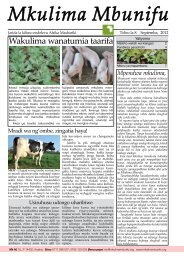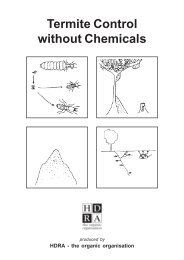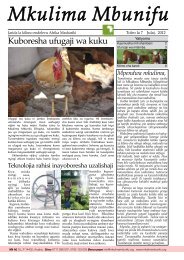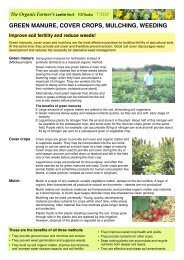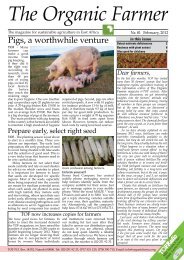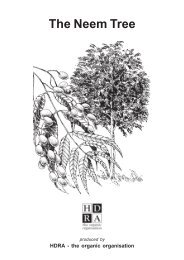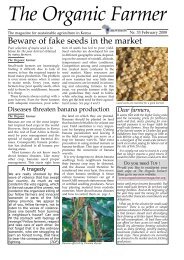TOF, Issue No 07, November 2005 - Infonet-Biovision
TOF, Issue No 07, November 2005 - Infonet-Biovision
TOF, Issue No 07, November 2005 - Infonet-Biovision
Create successful ePaper yourself
Turn your PDF publications into a flip-book with our unique Google optimized e-Paper software.
6 The Organic Farmer Nr. 7 <strong>No</strong>vember <strong>2005</strong> Su Kahumbu<br />
You have to feed the soil<br />
"Onions tend to do well when<br />
planted, then after one or two<br />
months , they turn yellow. The<br />
same happens to capsicums. What is<br />
wrong?" asks Evelyn Heyi from<br />
Bomet. Similar questions were<br />
coming from some other farmers.<br />
This sounds like a nutrient<br />
deficiency. Healthy plants are a deep<br />
green colour. Any signs of<br />
yellowing or purple colours indicate<br />
that the plants are hungry. Most of<br />
our tropical soils are not<br />
automatically very fertile. We have<br />
to both dig or plough the soils to<br />
give the plants air and loosen the soil<br />
for good root growth. And we have<br />
to feed the soil with good compost,<br />
manure or green manure (this means<br />
digging in live green plants) to<br />
activate all the good soil micro<br />
organisms, so they can help make<br />
the soil productive.<br />
The quickest way to restore a<br />
healthy colour and good production<br />
to a discoloured crop is foliar feed.<br />
There is one on the market, which is<br />
approved for organic farming, called<br />
"Freegrow" and is made from<br />
seaweed. However foliar feed can be<br />
made at home from any good<br />
Damage by bean aphids<br />
Isaak Maina Munyari from Subukia<br />
had his beans infested with dull-black<br />
small insects, and afterwards the<br />
beans were covered with a liquid like<br />
honey and did not do well.<br />
These insects are bean aphids. It is<br />
always useful to look carefully and<br />
control aphids at first signs of<br />
infestation as otherwise they will<br />
spread to the whole crop. If caught<br />
early the insects can be sprayed with<br />
either natural pyrethrum or neem in<br />
the spots where they are seen. But<br />
remember, if all plants are sprayed,<br />
we also kill the good insects that<br />
actually eat aphids, and so in the<br />
long run make a bigger problem for<br />
ourselves. Ladybird beetles (small<br />
red round beetles with black dots)<br />
eat aphids, and keeping a good<br />
population of ladybird beetles is a<br />
good insurance against heavy aphid<br />
infestation.<br />
smelling compost or dried manure.<br />
Put 5-10 kg compost or dried<br />
manure in a gunny bag and immerse<br />
in a drum of water. If EM (Effective<br />
Microorganisms) is available add<br />
about a cup to a drum of water, this<br />
will help extract the good nutrients<br />
while fermenting the mixture in a<br />
healthy way.<br />
Leave the bag in the water for<br />
some days - up to a week, then spray<br />
the solution - a cup in 20 l clean<br />
water on to the crop. (If you need<br />
more Information on EM contact<br />
Peter Chandi <strong>07</strong>33 546491)<br />
In the long run though there is no<br />
shortcut to feeding the plants well<br />
from even before planting.<br />
Compost making and/or green<br />
manuring and rotation of the crops<br />
is the backbone of organic farming.<br />
We have to feed the soil so it can<br />
feed us. The peppers above turning<br />
yellow in the third year have by<br />
then used up all the nutrients that<br />
the soil had to begin with, and<br />
unless more nutrients are fed to the<br />
soil, yields will continue to go<br />
down. Compost, manure and green<br />
manure also helps the soil to absorb<br />
water better during rains, and to<br />
hold more air for root growth.<br />
Nutrient deficiency symptoms<br />
Some of the most common nutrient<br />
deficiency symptoms:<br />
a) Nitrogen deficiency: Yellowing<br />
of older leaves first, then if serious<br />
all leaves turn yellow and the plant<br />
does not grow well.<br />
Nitrogen is found in urine, manure<br />
- especially chicken manure (careful<br />
- it might burn the plants if you put<br />
too much), compost and foliar feed.<br />
b) Phosphorous deficiency: Purple<br />
colours are seen and the plants grow<br />
slowly. Phosphorous is found in<br />
Majingu rock phosphate as well as<br />
animal manures.<br />
c) Potassium deficiency: Yellow<br />
spotted leaves with wilted leaf<br />
margins and tips. Sometimes leaves<br />
curl or crinkle. Often seen on<br />
brassicas, who really like their<br />
potassium. Potassium is found in<br />
wood ashes.<br />
d) Copper deficiency: First<br />
symptoms are wilting of leaf tips,<br />
yellow patches in the field when<br />
seen from far, and stunted growth.<br />
Copper is found in small quantities<br />
in animal manures, but the organic<br />
system allows the use of added<br />
copper when needed either as a seed<br />
treatment (copper oxychloride) or<br />
as a spray on young crops (see also<br />
page 3).<br />
MARIGOLD EXTRACT<br />
In page 3 we informed you on early<br />
and late blight. For lack of space we<br />
shifted one important advice to this<br />
page: Online Information Service for<br />
<strong>No</strong>n-Chemical Pest Management in<br />
the Tropics, OISAT, recommends<br />
the use of Marigold extract against<br />
early blight in tomatoes (see also<br />
www.oisat.org). Below is the recipe:<br />
Materials: Whole flowering plant<br />
Soap, Water, Strainer, Drum<br />
Preparation: Fill-in drum with ½ -<br />
3/4 full of flowering plants. Leave to<br />
stand for 5-10 days. Stir occasionally.<br />
Strain before use<br />
Use: Dilute the filtrate with water<br />
at a ratio of 1:2. Add 1 tsp soap in<br />
every litre of the extract<br />
How to control thrips?<br />
Cowpeas do well in Bomet, however,<br />
farmers here abandoned growing<br />
them due to the problem of thrips.<br />
Evelyn Heyi from Bomet asks: "How<br />
can we control this pests?"<br />
Thrips are very difficult to control.<br />
The best solution so far is a good<br />
rotation with non-legume crops,<br />
removal of all unused vines and leaves<br />
and composting or burning them,<br />
then planting a different crop in that<br />
area. However it is rumoured that<br />
ICIPE is doing research on thrips<br />
control, so the question is hereby<br />
forwarded to them.<br />
We will carry a story on thrips in the<br />
next issue. The Editors<br />
answers your<br />
questions<br />
assisted by<br />
Anne Nganga<br />
Write to:<br />
The Organic Farmer<br />
P.O.Box 14352, 00800 Nairobi<br />
KENYA<br />
Tel. 020 445 03 98<br />
e-mail : info@organickenya.com




